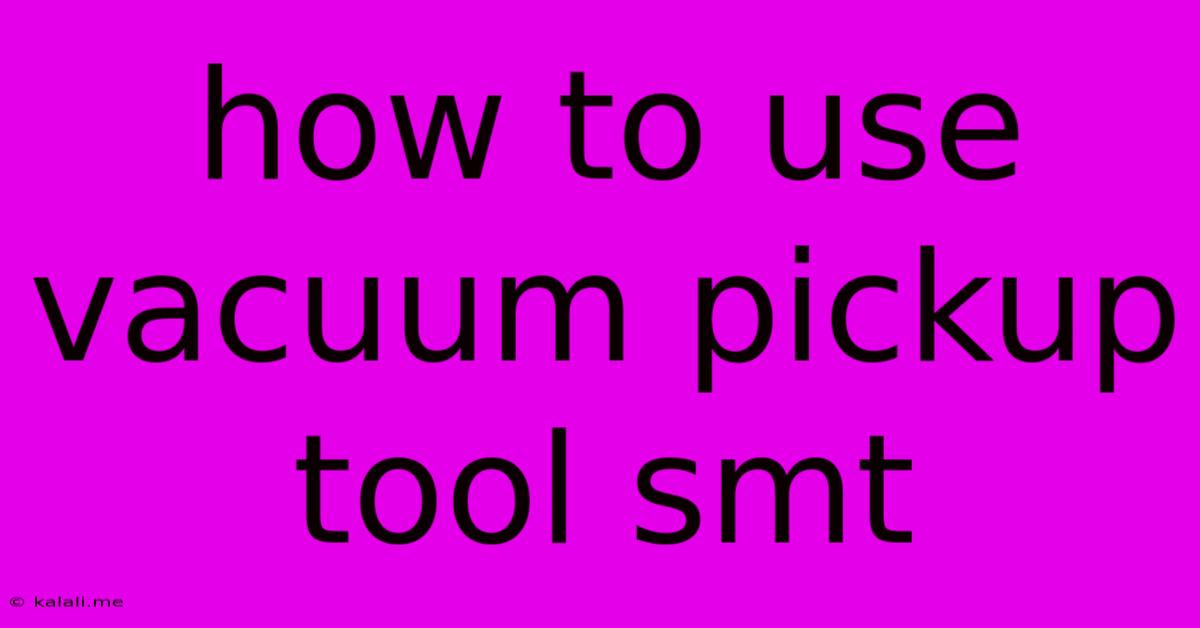How To Use Vacuum Pickup Tool Smt
Kalali
May 23, 2025 · 3 min read

Table of Contents
Mastering the SMT Vacuum Pickup Tool: A Comprehensive Guide
Picking and placing surface mount technology (SMT) components is a delicate process, requiring precision and efficiency. A vacuum pickup tool is an essential piece of equipment for any SMT rework or repair station, allowing for the safe and accurate handling of these tiny components. This guide will walk you through the proper usage and maintenance of an SMT vacuum pickup tool, helping you avoid damage and maximize efficiency. This will cover everything from choosing the right tool to advanced techniques for handling challenging components.
Understanding the Basics of Vacuum Pickup Tools
SMT vacuum pickup tools utilize a small nozzle connected to a vacuum source to gently lift and place surface mount components. The vacuum pressure is carefully regulated to provide enough suction to hold the component securely without damaging it, while also allowing for easy release. These tools come in various designs, each tailored to different component sizes and sensitivities. Key features to consider include nozzle size and material, vacuum pressure control, and ergonomic design.
Types of Vacuum Pickup Tools
- Handheld Vacuum Pickup Tools: These are the most common type, offering portability and ease of use for various tasks. They are ideal for smaller-scale rework and repair jobs.
- Stationary Vacuum Pickup Tools: Typically integrated into larger rework stations, these tools offer more consistent vacuum pressure and are often equipped with features like magnification and lighting.
- Automated Vacuum Pickup Tools: These are used in high-volume automated SMT assembly lines, offering speed and precision beyond the capabilities of manual tools.
How to Use an SMT Vacuum Pickup Tool Effectively
The process of using a vacuum pickup tool requires a gentle touch and careful attention to detail. Here's a step-by-step guide:
-
Proper Tool Selection: Choose a nozzle size appropriate for the component you're handling. Too small a nozzle might damage the component, while too large a nozzle might not provide sufficient suction.
-
Adjusting Vacuum Pressure: Start with a low vacuum pressure and gradually increase it until the component is securely held. Excessive pressure can damage sensitive components.
-
Component Placement: Carefully position the nozzle over the component, ensuring it's centered and making good contact. Avoid applying excessive force.
-
Lifting the Component: Gently lift the component using a smooth, upward motion. Avoid jerky movements that could cause damage.
-
Component Transfer: Carefully transport the component to its new location, maintaining a steady hand and avoiding sudden movements.
-
Component Placement: Position the component accurately over its designated location. Release the vacuum to place the component.
Troubleshooting Common Issues
- Component Not Picking Up: Check the vacuum pressure, ensure the nozzle is clean, and verify the nozzle is the correct size for the component.
- Component Slipping: Increase the vacuum pressure slightly, but avoid overdoing it. Ensure the nozzle is clean and making good contact with the component.
- Component Damage: Check for excessive vacuum pressure or improper handling. Use the correct nozzle size and ensure gentle movements.
Maintaining Your Vacuum Pickup Tool
Regular maintenance is key to ensuring the longevity and performance of your vacuum pickup tool.
- Nozzle Cleaning: Regularly clean the nozzle to remove any debris or residue that might affect suction.
- Vacuum Check: Periodically check the vacuum strength to ensure it is functioning properly.
- Handle Care: Keep the handle and other parts of the tool clean and free of any obstructions.
Advanced Techniques for Challenging Components
Handling particularly small, delicate, or oddly shaped components might require additional techniques. These include using specialized nozzles, employing a magnifying glass for improved visibility, or using a static-resistant mat to prevent electrostatic discharge (ESD) damage.
By following these guidelines, you can effectively utilize an SMT vacuum pickup tool, ensuring efficient and damage-free handling of your surface mount components. Remember, practice and patience are key to mastering this essential skill.
Latest Posts
Latest Posts
-
Can You Bring A Water Bottle On A Plane
May 23, 2025
-
Are Yellow Potatoes The Same As Yukon Gold
May 23, 2025
-
How To Get Olive Oil Out Of Clothes
May 23, 2025
-
Does Vbos Increase Fps Witha Good Gpu
May 23, 2025
-
How Did Howard Find Out Jimmy Throw The Bowling Balls
May 23, 2025
Related Post
Thank you for visiting our website which covers about How To Use Vacuum Pickup Tool Smt . We hope the information provided has been useful to you. Feel free to contact us if you have any questions or need further assistance. See you next time and don't miss to bookmark.